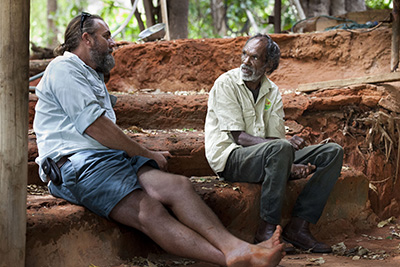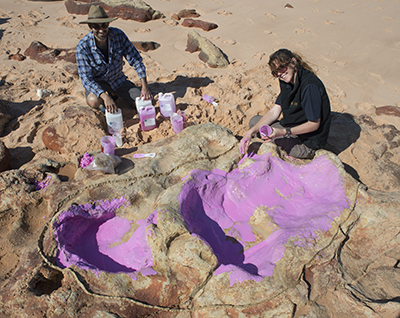An unprecedented 21 different types of dinosaur tracks have been identified on a 25-kilometre stretch of the Dampier Peninsula coastline dubbed “Australia’s Jurassic Park”.
A team of palaeontologists from The University of Queensland’s School of Biological Sciences and James Cook University’s School of Earth and Environmental Sciences braved sharks, crocodiles, massive tides and the threat of development to unveil the most diverse assemblage of dinosaur tracks in the world in 127 to 140 million-year-old rocks in the remote Kimberley region of Western Australia.
Lead author Dr Steve Salisbury said the diversity of the tracks around Walmadany (James Price Point) was globally unparalleled and made the area the “Cretaceous equivalent of the Serengeti”.
“It is extremely significant, forming the primary record of non-avian dinosaurs in the western half the continent and providing the only glimpse of Australia’s dinosaur fauna during the first half of the Early Cretaceous Period,” Dr Salisbury said.
“It’s such a magical place—Australia’s own Jurassic Park, in a spectacular wilderness setting.”
In 2008, the Western Australian Government selected Walmadany as the preferred site for a $40 billion liquid natural gas processing precinct.
 The area’s Traditional Custodians, the Goolarabooloo people, contacted Dr Salisbury and his team, who dedicated more than 400 hours to investigating and documenting the dinosaur tracks.
The area’s Traditional Custodians, the Goolarabooloo people, contacted Dr Salisbury and his team, who dedicated more than 400 hours to investigating and documenting the dinosaur tracks.
“We needed the world to see what was at stake,” Goolarabooloo Law Boss Phillip Roe said.
The dinosaur tracks form part of a song cycle that extends along the coast and then inland for 450 km, tracing the journey of a Dreamtime creator being called Marala, the Emu man.
“Marala was the Lawgiver. He gave country the rules we need to follow. How to behave, to keep things in balance,” Mr Roe said said.
“It’s great to work with UQ researchers. We learnt a lot from them and they learnt a lot from us.”
Dr Salisbury said the surrounding political issues made the project “particularly intense”, and he was relieved when National Heritage listing was granted to the area in 2011 and the gas project collapsed in 2013.
“There are thousands of tracks around Walmadany. Of these, 150 can confidently be assigned to 21 specific track types, representing four main groups of dinosaurs, ” Dr Salisbury said.
“There were five different types of predatory dinosaur tracks, at least six types of tracks from long-necked herbivorous sauropods, four types of tracks from two-legged herbivorous ornithopods, and six types of tracks from armoured dinosaurs.
“Among the tracks is the only confirmed evidence for stegosaurs in Australia. There are also some of the largest dinosaur tracks ever recorded. Some of the sauropod tracks are around 1.7 m long.”
“Most of Australia’s dinosaur fossils come from the eastern side of the continent, and are between 115 and 90 million years old. The tracks in Broome are considerably older,”
The research has been published as the 2016 Memoir of the Society of Vertebrate Paleontology.
Dino tracks_002 from The University of Queensland on Vimeo.
Media: Dr Steve Salisbury, s.salisbury@uq.edu.au, @implexidens, +61 7 3365 8548 or +61 407 788 660. Phillip Roe, Goolarabooloo, +61 427 425 238.
Additional images and video for media use can be found here and here, respectively. For further information contact Jan King, +61 (7) 33654043 or +61 427 559 427, j.king@uq.edu.au
Still images are available for use under a Creative Commons No Derivatives licence, meaning they can be used with attribution and without adaptation or change. The videos are available under a less-restricted Creative Commons licence to ensure they can be cut and mixed for media purposes. Attribution is still required. Please feel free to contact our media department on communications@uq.edu.au if you require further information about these licences.
For more information on Kimberley dinosaur tracks: UQ Dinosaur Lab and Dinosaur Coast Management Group
.jpg)

